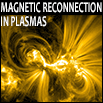Speaker
Dr
Gian Luca Delzanno
(Los Alamos National Laboratory)
Description
The Vlasov-Maxwell equations are a fundamental model for the
microscopic evolution of
magnetized, collisionless plasmas. Because of the wide disparity of
spatial and
temporal scales typical of plasmas, their numerical solution is
extremely challenging
and is a very active area of research.
There are three main numerical approaches to the solution of the
Vlasov-Maxwell
equations, differing by how phase space is handled. The most common
is the
Particle-In-Cell (PIC) method, where phase space is discretized by
using
macroparticles. In the second, called Eulerian-Vlasov, a computational
grid in phase
space is used. The third class of methods is the Transform methods,
where the plasma
distribution function is decomposed in a number of moments via a basis
expansion
(typically using the Fourier or Hermite basis). PIC is the most popular
method owing
to its simplicity and robustness. It has had remarkable success for
many basic plasma
physics problems. It is however plagued by statistical noise associated
with the
macroparticles and is therefore mainly suited for problems where a
high
signal-to-noise ratio is acceptable. Eulerian-Vlasov and Transform
methods do not
suffer from statistical noise, but can be memory and resource intensive
and,
therefore, so far have been mainly limited to problems with a smaller
number of
spatial/velocity dimensions.
In this work, we discuss a spectral method to solve the Vlasov-Maxwell
equations by
means of an expansion of the distribution function into Hermite
polynomials which
reduces the Vlasov equation to an infinite system for the moments of
the expansion.
The spatial discretization is cast either in terms of a Fourier (global)
basis or
through the Discontinuous-Galerkin (DG) method (local basis), while
the moment
equations are discretized implicitly in time with a Crank-Nicolson
scheme. The
resulting set of nonlinear discrete equations is solved with the Newton-
Krylov
technique, where GMRES is used for the inner iterations. For periodic
boundary
conditions, this discretization delivers a scheme that conserves the
total mass,
momentum and energy of the system exactly. For comparison, this is
something that has
not yet been accomplished for PIC.
A comparison between PIC and the spectral method on standard test
problems such as
Landau damping, two-stream instability and ion acoustic wave shows
that the spectral
method can be orders of magnitude faster/more accurate than PIC.
Multi-dimensional
fully electromagnetic tests involving high frequency plasma waves and
the whistler
instability will also be presented. In multi-dimensions preconditioning
strategies
become crucial to maintain the scalability of the algorithm as the
dimension of the
Krylov space increases. We present two preconditioning strategies
showing that an
order of magnitude decrease in the Krylov iterations and a sizeable
gain in code
speed-up can be achieved. Some attempts to optimize the spectral
decomposition in
velocity space will also be presented, including a method where the
number of Hermite
modes is changed dynamically during the simulation.
Primary author
Dr
Gian Luca Delzanno
(Los Alamos National Laboratory)

